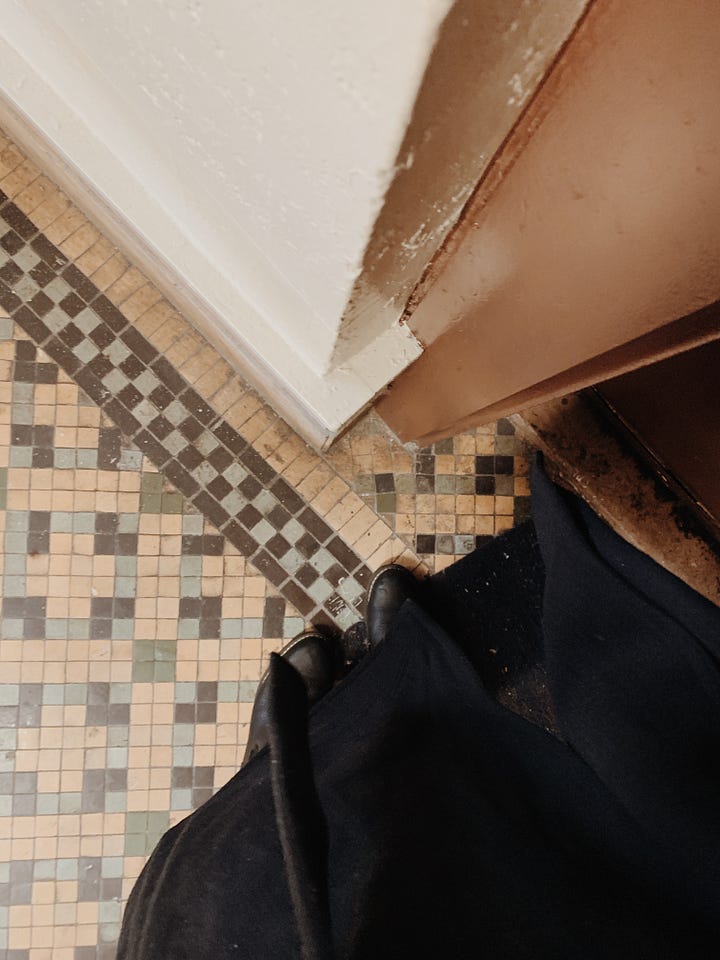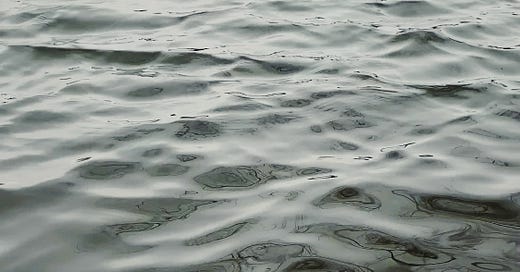We arrive to a room where we sit around making. There are piles of paper, brushes and ink, momentary compressions of stitches and glue to be made, layers of readiness and attention and anticipation, chairs and stools at the waiting in the . There is the stillness, the silence, four walls, and a wooden table. Then, arrival. Then, the sharing of space and time, expression and expressing of voices, the lifting and placing of hands and tools, of thoughts and ideas, pens and measurements, and techniques, in this gathering place of creating, expressing, and containment. The room holds us, the ideas contain us, and we are guided by time, theme, following focus and its opposite equally through creative forms. For a time, we are held together: in community, in practice, in conversation, in containing.
I arrive to the week considering this idea of containers in the act of creating — the literal and psychic spaces of holding and being together temporarily or with endurance of commitment and time. I’m eager to investigate in mind and body its many facets and forms. What does it mean, feel like to be contained? How is it practiced or embodied, this idea of containing, why is it important? I start by writing, giving over ink to the fibers of paper, giving ideas to the wide unknown of a blank page. Then I feel into it while walking. Then I let it go for a while, dissolve the focus, and do something different.
Container arrives this morning as my conscious mind does: I feel the edges of my body and breath, feel the edges of sleep and bed. Container arrives in the form of intention, the guiding aim, the quality of heart, the things that are cared for and tended to over time, in the act of remembering and repetition. A container is a kind of ground, much like the soil sinks down and stays to hold the rivers, tides, oceans, and waves; a sturdy space within which we can flow. A container is part of life’s undulating nature, is not fixed or rigid, ideally, is something we have agency to craft and morph and transform, to strengthen, tear down, and come back to.
I am thinking about containers: personal, collective, domestic, public, in communal and in third spaces. Sitting around a wooden table or some amalgam of gathering asking questions and placing their responses down, letting the not known linger. There, we are held together in the walls, in the atmosphere. Larger, I consider the environments that we’re a part of, layers of oxygen, containers of starlight, and my once-fixed view of containment expands.
This containment is a relationship, inherent to our creative natures. It’s a sturdy place, grounded, and still adaptable: not too fixed or rigid, not too open or expanded. A creative practice is a living thing that we craft like the breath in the body, in the tandem conversing between two or more people, one that, like life expands and condenses, shifts and expands based on need, drive, desire. I wake up to the breath, breathing in, think into the space of an idea, find out where the edges of capacity are. On days when I feel braver, need for more, or want to practice maintaining this shape, I bring in the breath deeper: one, two sips more.
Then, from the space of the small breath, I turn my attention to larger spheres. Time is a container we make our meetings and our days within. Tasks get checked off the to do lists. Ideas are containers we tend to like seeds in the soil. The sky, in some ways, is a kind of container, though if I look too hard and think too wide about the sky, I remember we are each small specks, immense hearts and minds at once, in an infinitely expanding universe, on a morphing rock whirring around, and it is at once mesmerizing and intriguing, then at times becomes dizzying. To come back to earth, I refocus on my feet, remembering gravity, feeling the weight, remembering the edges of the body, connected ever to the edges of the earth.
I walk home after teaching, and I think about containers, how creativity can be at once an incubator, a holding ground, and a vessel for expanding, or pouring out of. Creativity feels like a conversation, one between containing and holding; allowing for space and time to grow and thrive; and then, finally, releasing, if the time is right. Last night a snow fell and I felt the sky rain down in multiple dimensions, no longer a dark black swath, no longer just a grounding, snow fell from the sky, reminding me of the distance between cloud and ground, activating this conversation between sky, self, and environment. Snowflakes fell, cold against hot cheeks, piling up on the edge of black wool coats. They are stark and white and falling. They reminded me of atmospheres and containers.


Etymologically, “container” comes back to holding, holding together, a way of enclosing. Sharing a root with (co)mmunity, (co)ntaining is a practice, of being with, being together. In community we are creating together: body, breath, action, idea. Shape, sense, space. In our own bodies and minds, we are this infinite system of collaboration: synapses form, we dance between conscious and unconscious, known and unknown, while muscles lift and place, our minds lift and place and generate based on histories, sensitivities, stimuli, aims, drives, intentions, needs, and desires.
I feel into container as a living, breathing, flexible form: a way of being with life, offering ourselves structure, but with the breathability of moveable forms — some level of ease. An idea is a container, a seed is a container, a community is a way of containing; a womb, a book, a cup, a bowl, a vessel, a boundary. The walls of a room, a home, a tent, a subway, a city, a culture, our own bodies, a relationship, a conversation, a time frame. We determine the density of the walls, how porous the vessel is, how adaptable and flexible, how nomadic the practice. Sometimes, we build and rebuild, reinforce, and tend to these containers. Others, we smash into pieces.
I enter into the day filling the holding space of the cavern of my torso with breath. Lungs expand and contract. This is the process. They are my embodied teachers of limits, expansion, condensing down, and capacity. We breathe in and feel our own lightness, we feel our density, where the edge is. That tool is a kind of container. Soon, I’ll make a soup, and the oils will break away from the bones, collagen will separate, flavors will expand and break down and blend in the soup pot, the whole container. In the mind, attention is a something I hold, condense down, contain and expand within a fine space, feel in the cavernous center of the body, or compress down and tune into space just there so small at the tip of the nose until I finally let it flow and release.
An intention is something that helps create, contains, and holds. It is the base of the river that holds the water and the rainfall, the cycles of weather and repetitions of visiting. Through repetition, we learn how strong the walls are, what our capacities are, what we’re devoted to, what builds us up, what pushes at our walls and our seams, what tears through, and what it takes to bring ourselves back — to this living, breathing act of creativity and containing and process.
A page is a container too, as is a canvas, a meal, a song, a time frame. As I walk through cities, thoughts, ideas, exploring boundaries and freedoms, I tune in: is this expanding or contracting? Is this thought a prism or a prison? What about this feeling? What does it contain? What are the ingredients here?
Sometimes, creating the container for my own practice seems to be: turn down the lights, turn off the phone, exist for a minute or ten in silence. It’s a practice of reading the room: tuning into our own interiors, or minding our own shared spaces, ecosystems, our practices of relating. What are we crafting here together in this time, moment, space? What’s the quality of this moment — its color, density, intensity, texture? Is this supportive or too rigid or somewhere in between? Is this open or too flexible? Is this opening or containing?
What does containing mean to you?
nourished by, nourishing:
Reading | Half of Ideal Suggestions: Essays in Divinatory Poetics by Selah Saterstrom
Making | cumin coffee rubbed chicken, roasted, and then soup after. pretending dill is snow, scattering it around the bowl. topped with yogurt. also, shapes in the snow on the sidewalk outside; that counts as drawing. restocking map journals.
Enjoying | teaching, Pinot Noir, friendships, attempts at sleeping, evenings
Watching | Fleabag, again (and again)
upcoming experiences:
1/17 Beginner’s Journaling
1/24 Taste + Write: Meditating on the Senses
1/31 Bookbinding: Pamphlet Stitch
2/4 Greenpointer’s Market





